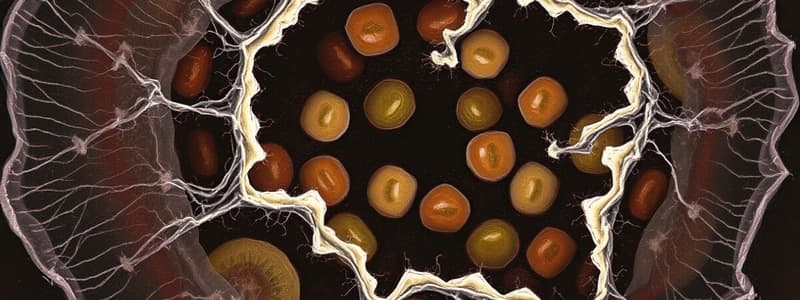Podcast
Questions and Answers
What structure in compact bone contains blood vessels and nerves?
What structure in compact bone contains blood vessels and nerves?
- Osteon
- Central canal (correct)
- Canaliculi
- Lacunae
Which of the following statements about osteocytes is true?
Which of the following statements about osteocytes is true?
- They are located in the central canal.
- They occupy the lacunae. (correct)
- They are responsible for producing the bone matrix.
- They form the concentric lamellae.
What is the primary function of canaliculi in bone structure?
What is the primary function of canaliculi in bone structure?
- To hold blood vessels in place.
- To provide structural support to the bone.
- To facilitate nutrient and waste exchange between osteocytes. (correct)
- To connect the periosteum to the central canal.
What term describes the concentric layers of bone matrix surrounding each central canal?
What term describes the concentric layers of bone matrix surrounding each central canal?
What is the role of the periosteum in bone structure?
What is the role of the periosteum in bone structure?
What is the primary function of tight junctions in epithelial cells?
What is the primary function of tight junctions in epithelial cells?
Which component of desmosomes plays a significant role in resisting mechanical stress?
Which component of desmosomes plays a significant role in resisting mechanical stress?
What is true about gap junctions?
What is true about gap junctions?
How do hemidesmosomes function in epithelial tissues?
How do hemidesmosomes function in epithelial tissues?
Which feature distinguishes gap junctions from tight junctions and desmosomes?
Which feature distinguishes gap junctions from tight junctions and desmosomes?
What is the significance of the centrally located nucleus in cell sectioning?
What is the significance of the centrally located nucleus in cell sectioning?
What might happen if a slice of a cell misses the nucleus?
What might happen if a slice of a cell misses the nucleus?
Why is the size of the nucleus important in cell sectioning?
Why is the size of the nucleus important in cell sectioning?
What does a cross-section of a hollow structure reveal?
What does a cross-section of a hollow structure reveal?
What distinguishes a longitudinal section from a cross section?
What distinguishes a longitudinal section from a cross section?
What can affect the appearance of a cell nucleus in sectioning?
What can affect the appearance of a cell nucleus in sectioning?
What might be an outcome of an inaccurately cut slice through a tubular organ?
What might be an outcome of an inaccurately cut slice through a tubular organ?
What is a common aspect to observe in sections of tubular organs?
What is a common aspect to observe in sections of tubular organs?
What is the main characteristic of holocrine glands?
What is the main characteristic of holocrine glands?
Which of the following best describes the cutaneous membrane?
Which of the following best describes the cutaneous membrane?
What type of tissue forms the serous membrane?
What type of tissue forms the serous membrane?
What is the primary function of mucous membranes?
What is the primary function of mucous membranes?
Which membrane is specifically associated with lining joint cavities?
Which membrane is specifically associated with lining joint cavities?
What role do mast cells play in the response to a wound?
What role do mast cells play in the response to a wound?
What happens to blood vessels during the inflammatory response to a wound?
What happens to blood vessels during the inflammatory response to a wound?
What components are carried by blood plasma that seeps into a wound?
What components are carried by blood plasma that seeps into a wound?
Which of the following is NOT a function of the inflammatory response to a wound?
Which of the following is NOT a function of the inflammatory response to a wound?
Which statement about the initial response to a severed blood vessel is accurate?
Which statement about the initial response to a severed blood vessel is accurate?
Flashcards are hidden until you start studying
Study Notes
Cell Sectioning
- Cells can be sectioned into slices, often revealing a centrally located nucleus.
- Variability in slices can lead to some missing the nucleus or showing a reduced size.
Bone Structure
- Compact bone consists of cylinders called osteons that encircle central (Haversian) canals.
- Central canals run longitudinally and house blood vessels and nerves.
- Bone matrix is structured in concentric lamellae, resembling layers of an onion.
- Osteocytes are mature bone cells found in lacunae; they communicate via canaliculi, delicate canals linking lacunae.
Connective Tissue Membranes
- Periosteum is a tough fibrous connective tissue that covers bones.
- Various types of membranes line body cavities; key types include:
- Cutaneous membrane: The skin, serving as a protective dry barrier.
- Mucous membrane (mucosa): Lines openings to the external environment.
- Serous membrane (serosa): Simple squamous epithelium over areolar tissue; produces serous fluid.
- Endothelium: Lines blood vessels and the heart.
- Mesothelium: Lines body cavities like the pericardium and pleura.
- Synovial membrane: Connective tissue lining joint cavities, secreting synovial fluid.
Cell Junctions
- Tight Junctions: Encircle epithelial cells, sealing intercellular space and preventing passage between cells.
- Desmosomes: Structural patches that hold cells together, resisting mechanical stress. Hemidesmosomes anchor basal epithelial cells to the basement membrane.
- Gap Junctions: Formed by connexons (transmembrane proteins) allowing communication between cells, facilitating the transfer of ions and small molecules.
Holocrine Glands
- Holocrine glands accumulate secretory products until the entire cell disintegrates, secreting a combination of cell fragments and synthesized substances (e.g., oil glands in the scalp).
Wound Healing Process
- Following injury, severed blood vessels lead to bleeding; mast cells release histamine, dilating blood vessels.
- Increased blood flow enhances permeability of capillaries, allowing plasma (containing antibodies, clotting proteins, and blood cells) to seep into the wound, aiding in the healing process.
Studying That Suits You
Use AI to generate personalized quizzes and flashcards to suit your learning preferences.




